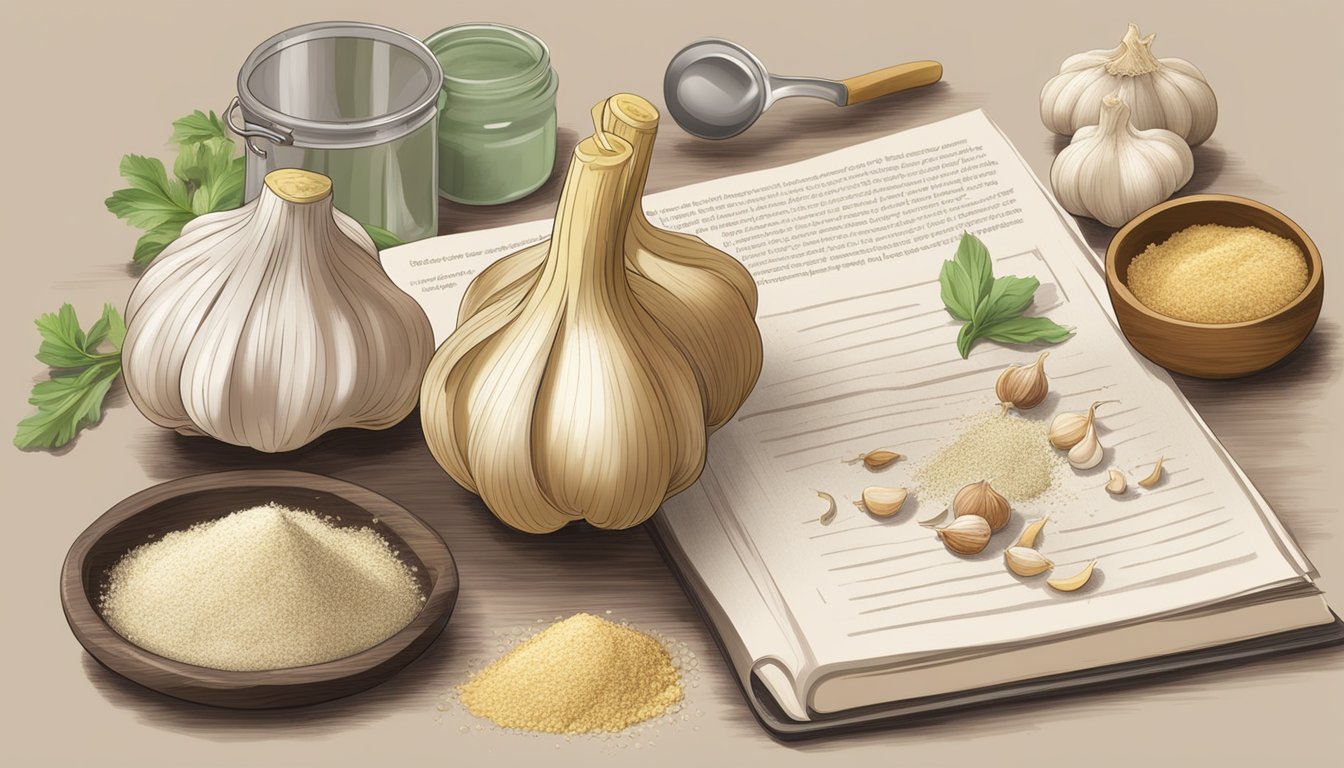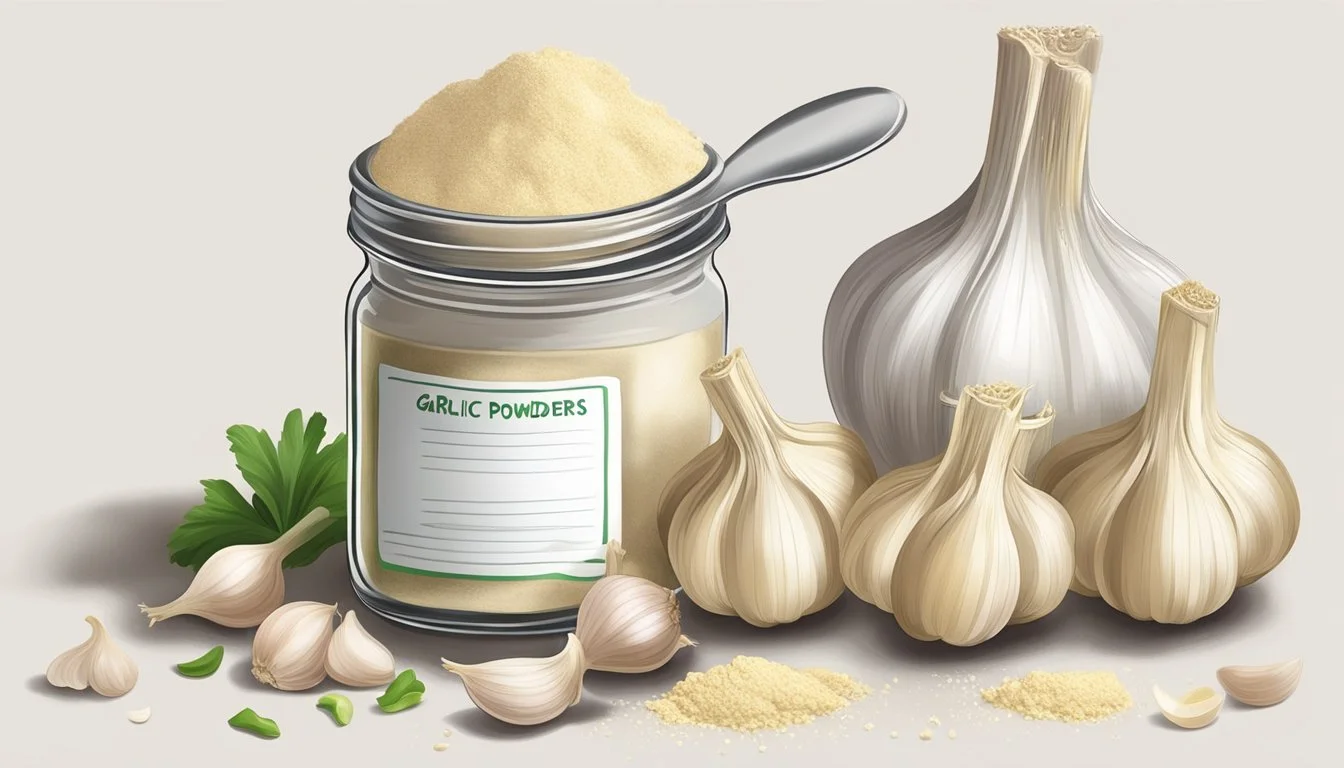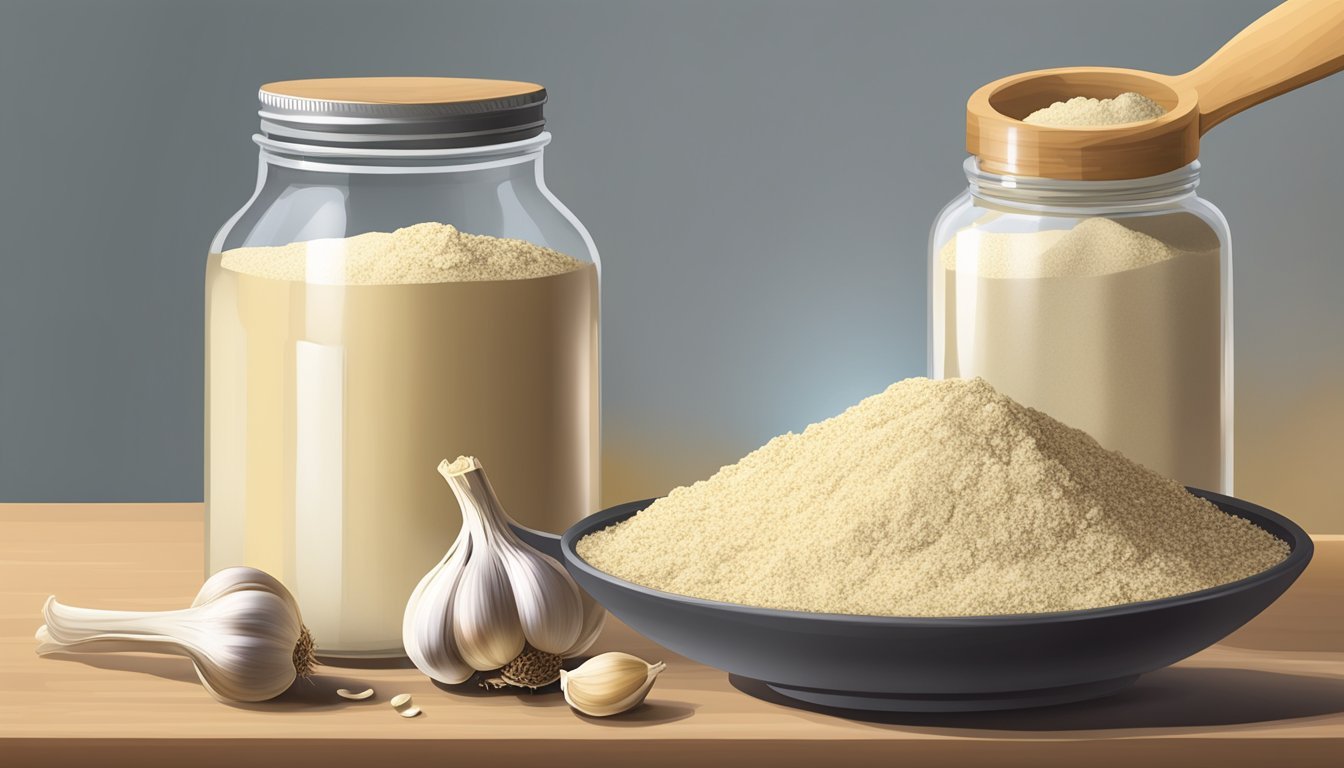How to Substitute Garlic Powder for Fresh Garlic
A Simple Conversion Guide
Understanding how to substitute garlic (What wine goes well with garlic?) powder for fresh garlic is essential for any cook facing an empty garlic bulb basket or for those looking to simplify their kitchen work without sacrificing flavor. Garlic powder offers a convenient and longer-lasting alternative to fresh garlic, and it can be particularly useful for those times when you need a burst of garlic taste without the texture of fresh cloves.
However, cooks should be aware of the potency difference between the two forms of garlic. Garlic powder is more concentrated and has a distinct taste profile compared to that of fresh garlic, which means the substitution requires a careful balance to maintain the desired flavor of the dish.
Substituting garlic powder for fresh garlic starts with understanding the proper ratios. As a rule of thumb, one fresh clove of garlic can typically be replaced with 1/8 teaspoon of garlic powder. This seems like a small amount because the powder is a dehydrated version of garlic cloves, containing all of the flavor in a more compact form.
Understanding Garlic Varieties
The culinary world embraces a variety of garlic forms, each with unique properties, flavors, and uses in cooking. From fresh bulbs to dehydrated condiments, understanding these varieties is key to successful recipe substitutions.
Fresh Garlic Essentials
Fresh garlic cloves come from the garlic bulb, a staple in kitchens worldwide. Its pungent flavor and aroma are slightly sweet when the garlic is cooked. Each clove size can vary significantly, affecting the intensity of flavor it imparts to dishes.
Size of Clove: Typically 1 to 1.5 inches in length.
Flavor: Pungent, aromatic, becomes sweeter upon cooking.
Use: Versatile, used in a variety of culinary applications.
Garlic Powder Profile
Garlic powder is made from dehydrated ground garlic cloves, offering a convenient and long-lasting alternative to fresh garlic. It provides a concentrated flavor, hence it should be used sparingly compared to its fresh counterpart.
Texture: Fine powder.
Flavor: Concentrated, potent.
Conversion: 1/8 teaspoon garlic powder is equivalent to 1 clove of fresh garlic.
Other Forms of Garlic
Apart from fresh garlic and garlic powder, other forms include:
Garlic Flakes: Also known as dehydrated minced garlic; 1/2 teaspoon replaces 1 clove of fresh garlic.
Granulated Garlic: Coarser than garlic powder; 1/4 teaspoon is equivalent to 1 clove of fresh garlic.
Garlic Salt: A blend of garlic powder and salt; use 1/2 teaspoon to replace 1 clove, adjusting the salt in the recipe accordingly.
Garlic Juice: Rarely used for substitution due to its mild flavor and liquid form.
Each form has its place in the kitchen, and knowing how to interchange them will ensure the essence of garlic is never missed in any dish.
The Role of Garlic in Cooking
Garlic is an essential ingredient that imparts a distinctive flavor and can influence the texture of dishes. It is used in various forms and its application can vary depending on the cuisine and the specific dish being prepared.
Garlic in Flavor Profiles
Garlic's signature taste is at the heart of its role in culinary arts. It can both stand out as a star in dishes like garlic butter shrimp or blend harmoniously with other ingredients in salad dressings, pasta sauces, and marinades. Chefs rely on garlic to contribute a depth of flavor that is slightly spicy, warm, and earthy. In salads and sauces, it can be the subtle note that brings other flavors together.
Salad Dressings: Garlic adds a pungent kick.
Marinades: It is a core component that tenderizes and infuses meats.
Garlic's Influence on Texture
The texture garlic imparts to a dish varies with its physical form. Whole cloves might be included in a stew to infuse flavor while leaving a soft, mellowed bulb behind. Minced or crushed garlic creates a more pronounced granular texture that can be desirable in dishes like mashed potatoes or pork chops. (What wine goes well with pork chops?) When making a stir-fry, finely chopped garlic distributes evenly, releasing its juices and flavor more rapidly.
Soups: Provides a smooth or chunky texture depending on how it's prepared.
Stir-Fry: Offers a subtle crispness when lightly cooked.
Common Garlic-Based Dishes
Garlic is a cornerstone in many iconic dishes around the world due to its robust flavor and versatility. Pasta dishes, from a simple garlic and oil spaghetti to a rich Bolognese sauce, often use garlic as a foundational flavor. Garlic is an indispensable ingredient in stews and soups, where it mellows into a gentle, savory background note. Mashed potatoes with roasted garlic or garlic-infused salad dressings are popular for their hearty and comforting tastes.
Pasta: Elevates the dish with its penetrating flavor.
Stews: Adds a complex, aromatic quality.
Mashed Potatoes: Infuses a creamy texture with rich flavors.
Determining Garlic Substitution Ratios
When substituting garlic powder for fresh garlic, it's crucial to understand the conversion factors that maintain flavor integrity. Below are the specific guides for making conversions between different forms of garlic.
Conversion Factors
Garlic powder is more concentrated than fresh garlic, and it lacks the moisture content found in fresh garlic. Therefore, one needs less garlic powder to achieve the same flavor intensity. The conversion ratio generally recommended is:
1 clove of fresh garlic is approximately equivalent to 1/8 teaspoon of garlic powder.
Fresh to Powder Equivalents
When recipes call for cloves of garlic, one can reference the following table for substitution with garlic powder:
Fresh Garlic Garlic Powder 1 clove 1/8 tsp 2 cloves 1/4 tsp 3 cloves 3/8 tsp 4 cloves 1/2 tsp
This table should serve as a starting point for substitution.
Adjusting for Intensity
Since garlic powder has a more concentrated flavor, one should start with less and adjust according to taste. This is particularly important when swapping it in for fresh or minced garlic in recipes where garlic isn't the primary flavor. Taste tests are recommended before the finalization of the dish to ensure the correct intensity.
Culinary Techniques with Garlic Substitutes
When substituting garlic powder for fresh garlic, one needs to consider the concentration of flavor and how it integrates with other cooking ingredients. Each culinary technique may require a different approach to keep the balance of flavors intact.
Using Garlic Powder in Marinades and Rubs
For marinades and rubs, garlic powder is an ideal choice because of its fine texture and ability to blend evenly with other spices. In marinades, garlic powder easily dissolves, ensuring a uniform distribution of garlic flavor throughout the protein. Typically, one-eighth teaspoon of garlic powder is equivalent to one clove of fresh garlic. To make a robust rub or marinade, combine garlic powder with complementary spices like paprika, black pepper, and dried herbs.
Integrating into Soups and Sauces
When adding garlic powder to soups or sauces, it should be done earlier in the cooking process to allow it to hydrate and release its flavors. A good rule of thumb is to use one-fourth teaspoon of garlic powder for each clove of fresh garlic called for in the recipe. Adding the garlic powder during the sautéing of base ingredients like onions (What wine goes well with onions?) or celery (how long does celery last?) can help bloom its flavor, leading to a more cohesive taste profile in the final dish.
Garlic Alternatives for Sautéing and Dressings
While sautéing, chefs may choose to blend garlic powder with the cooking oil or fat before introducing other ingredients into the pan. This can help replicate the infusion of flavor that sautéing fresh garlic offers. For salad dressings, where fresh garlic is often preferred for its punch, garlic powder serves as a more subdued, but still flavorful, alternative. Begin with less garlic powder, taste, and then adjust, using approximately one-eighth teaspoon of garlic powder to replace each clove of garlic. If creating a garlic butter, mix garlic powder into softened butter along with herbs to ensure the flavors meld together.
Alternative Garlic Flavorings and Substitutes
When fresh garlic or garlic powder is unavailable, consideration of the dish's required flavor profile is key. The following substitutes can deliver a similar taste profile or add their unique nuances to a recipe.
Using Onions and Shallots
Onions and shallots offer a milder taste but can emulate the pungency of garlic. For cooking purposes, if a recipe calls for one clove of garlic, one can substitute that with:
Yellow onion: Use approximately 1 tablespoon of chopped onion.
Shallot: About 1 to 1 and a half teaspoons of chopped shallot can be used due to its more delicate flavor.
Exploring Aromatic Herbs
Herbs enrich dishes with layers of flavor. In the absence of garlic, one can employ:
Chives: (how long do chives last?) These fine herbs can provide a slight onion-like flavor without overpowering a dish. Use them snipped as a garnish, or about 1 tablespoon chopped for every garlic clove.
Garlic chives: They possess a more garlicky taste and can be employed in the same amount as regular chives for a closer match to garlic's flavor.
Substitutes for Specialized Cooking
Some recipes may call for flavor profiles that traditional garlic allies like onions cannot fulfill. For these cases, consider:
Asafoetida powder: A staple in Indian cuisine, it produces a savory, umami quality similar to garlic. A pinch of asafoetida can replace a clove of garlic.
Ginger: While distinct from garlic, ginger can complement a range of dishes with its warm, spicy note. Use 1 tablespoon of minced ginger to replace a clove of garlic when a zesty flavor is desired.
In conclusion, while garlic has a distinctive flavor, these alternatives can suffice when it's unavailable and can even add their own unique dimensions to a recipe.
Health Benefits and Nutritional Values
When substituting garlic powder for fresh garlic in recipes, it’s important to consider both the health benefits and nutritional content. This section provides a detailed examination of garlic's positive health impact and compares the nutritional values of raw garlic versus garlic powder.
Garlic’s Impact on Health
Garlic has long been recognized for its health-promoting properties. Studies indicate that it can have a significant impact on lowering blood pressure and improving cardiovascular health. Garlic contains compounds such as allicin which are thought to possess antioxidant qualities, supporting the body's protective mechanisms against oxidative damage.
Nutritional Content Comparison
Nutrient Fresh Garlic (per clove) Garlic Powder (1/3 tsp) Calories 4.5 2.25 Vitamin C 1% of RDA Substantially less Other Vitamins Traces of B-vitamins Traces of B-vitamins Minerals Manganese, selenium Reduced quantities Proteins 0.2 grams 0.1 grams Antioxidants Allicin Less due to processing
Fresh garlic cloves contain vitamins such as vitamin C and traces of B-vitamins, and are a good source of minerals like manganese and selenium. The antioxidant content of fresh garlic, especially allicin, is higher than in garlic powder. Raw garlic, therefore, tends to offer more health benefits than its powdered counterpart. However, garlic powder still retains some minerals and is low in calories, making it a convenient and healthier alternative to salt in many recipes.
Tips for Storing and Handling Garlic
Proper storage and handling are essential to preserve the flavor and longevity of both fresh garlic and garlic powder. By following specific practices, home cooks can ensure these pantry staples maintain their quality.
Preserving Fresh Garlic
Fresh garlic bulbs should be kept in a cool, dry place with adequate air circulation. A common method is to store them in a mesh bag or a basket in a pantry or kitchen cabinet, away from direct sunlight and moisture which can lead to sprouting or mold. Individual cloves can be peeled and stored as garlic puree or frozen garlic for convenience. To freeze garlic:
Peel the cloves and place them whole, chopped, or as a puree in an airtight container or freezer bag.
Label the container with the date to keep track of freshness.
Maintaining the Quality of Garlic Powder
Garlic powder, a valuable ingredient for many home cooks, should be stored in a dark, cool cupboard away from sources of heat like the stove or oven. The container must be airtight to prevent moisture from causing clumps and to preserve the garlic's potent flavor. To maintain its quality:
Keep garlic powder in its original packaging if it reseals well, or transfer it to a small, airtight jar.
Use a dry spoon to measure it out when cooking, as moisture from a wet spoon can lead to spoilage.
Garlic in Regional Cuisines
Garlic, an indispensable ingredient, imparts distinctive flavors that are celebrated in various regional cuisines. Its application ranges from fresh to powdered forms, often adapted to local tastes and culinary techniques.
Garlic Usage in Mediterranean Cooking
In Mediterranean cooking, garlic is central to the creation of a myriad of dishes, from sauces to salads. Countries such as Italy, Greece, and Spain rely on garlic's robust flavor to enhance traditional recipes. Italian chefs often incorporate garlic into tomato-based pasta sauces, while Grecian kitchens may include it in dressings for fresh salads. The use of garlic powder can be suitable for quick seasoning or when fresh garlic is unavailable. In Mediterranean cuisine, the ratio of fresh to powdered garlic is crucial to maintain the intended flavor profile.
Fresh Garlic: For robust flavor in sauces and soups
Garlic Powder: Convenient for even distribution in dressings
Garlic in Asian Cuisine
Garlic's role in Asian cuisine cannot be overstated; it serves as the foundational element for many sauces, soups, and stir-fry dishes. Differing across regions from China to Thailand, garlic adds a pungent taste that can define a dish. Korean cuisine, for instance, incorporates garlic for both its flavor and purported health benefits. When substituting with garlic powder in these cuisines, chefs should ensure it is well-balanced with other flavors such as ginger and chili.
Soups: Garlic enhances the savory notes
Stir-fries: Fresh garlic is typically preferred for its bold taste
Local Variations in the United States
In the United States, the use of garlic varies widely, with California being noted for its garlic production. The Californian cooking scene often uses garlic in diverse ways, influenced by both Mediterranean and Asian cuisines. In areas where garlic is grown locally, such as in California, chefs might opt for fresh garlic in their preparations, while in other regions, garlic powder can serve as a convenient substitute, particularly in rubs and marinades for grilled meats.
Grilled Meats: Garlic powder for easy application in rubs
California: Known for both garlic cultivation and its use in fresh and inventive dishes
Through these regional glimpses, it becomes evident that while garlic's form might change, its presence remains non-negotiable across cuisines.
Frequently Asked Questions
In this section, one will find precise measurements for substituting garlic powder in place of fresh garlic, how to adjust for flavor preferences, and what alternatives to consider if allergic to the allium family.
Substitute Proportions and Measurements
To replace fresh garlic with garlic powder, the key is to understand the correct proportions required to achieve a similar flavor intensity. For every one clove of garlic, typically one should use 1/8 teaspoon of garlic powder. This ratio ensures that dishes retain the desired garlic taste without overwhelming other flavors.
Garlic Substitutes:
Garlic Paste: 1 teaspoon equals approximately 1 clove of fresh garlic.
Minced Garlic: 1/2 teaspoon usually equates to 1 clove of garlic.
Granulated Garlic: Use 1/4 teaspoon to substitute for 1 fresh garlic clove.
Garlic Flakes: Roughly 1/2 teaspoon is equal to 1 clove of garlic.
Flavor Adjustments for Dietary Preferences
For those who have specific dietary preferences, such as reduced sodium or a milder garlic flavor, adjustments can be made. Using slightly less garlic powder than the recommended substitute amount can moderate the garlic flavor. It’s also beneficial to add the garlic powder early in the cooking process to allow its flavor to mellow out during cooking, which can make it more palatable for sensitive taste preferences.
Flavor Adjustments:
For milder taste: Consider starting with half the recommended amount and adjust based on taste.
For a more robust garlic flavor: One may slightly increase the garlic powder or add it later in the cooking process.
Selecting Garlic Substitutes for Allium Allergies
Individuals allergic to alliums may need to avoid garlic and its relatives completely. In such cases, one can look to alternatives that impart a savory note without involving the allium family. These substitutes include:
Fennel (how long does fennel last?): A vegetable that offers a mildly sweet flavor and can be sautéed to replace the texture of garlic.
Celery: With its clean, slightly peppery taste, celery can provide a flavor boost in dishes normally requiring garlic.
Ginger: Not related to the allium family, ginger gives a different yet piquant flavor profile and can be used in a pinch to add zest to recipes.






